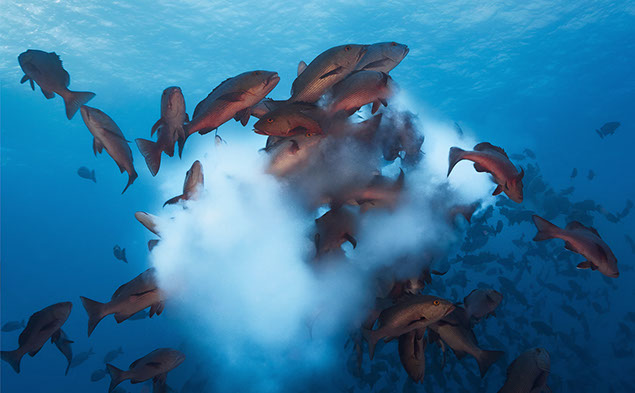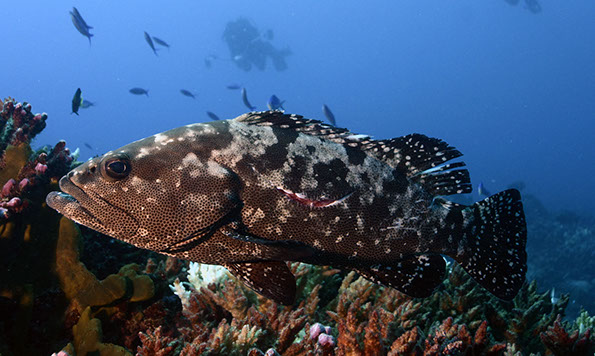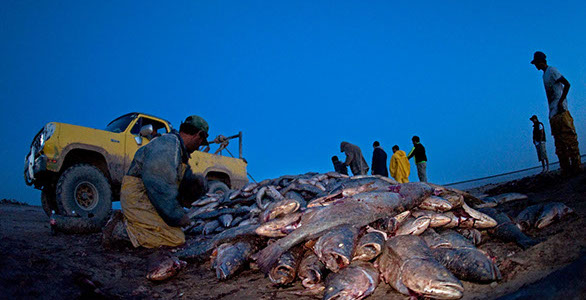
Research by Professor Yvonne Sadovy, marine scientist in the School of Biological Sciences and Swire Institute of Marine Science, suggests that aggregating spawners face very specific threats which are leading to alarming falls in their numbers, but because they are generally seen and caught in large groups their declines are going unnoticed. These fishes include many that we eat regularly, including cod, pollock and grouper.
“It’s hard to get across the message that you need to manage this when the fish numbers still appear healthy,” said Professor Sadovy, whose findings were published recently in the journal BioScience. “People see an abundance and think there is no problem, but this is an ‘illusion of plenty’ – it is that very abundance that needs protecting.
“The perception is that the sea is so big, if the fish decline in one place you can just go elsewhere and catch them. But we’re reaching a global limit with our fisheries. This is particularly so if we catch fish while they are spawning – the bottom line is if they don’t breed, the population will decline and many fish species need to breed in large numbers to be most productive. Because breeding fish numbers are declining, what we are now seeing is not a slow decline, but populations that appear to be healthy suddenly crashing.
“Also, people believe that seafood production is somehow under control – there is an assumption for example, that fish farming will solve the problem. But as farming increases, fishing continues; fishing does not replace farming, we do them both. Spawning fish aggregations are not seen as a priority for management. If you look at fisheries ‘management tools’ such as quotas, fishing licences etc, none specifically address spawning aggregations – they are falling through the cracks of fisheries management and conservation actions.”
The problem goes beyond the large numbers being caught in aggregations (lethal effects); there are also non-lethal side effects to this kind of fishing. When a trawling fleet interrupts a spawning aggregation the fish scatter. They may gather again to continue mating, but this means that reproduction time is cut so not as many eggs are produced. Further, these aggregations are not just about breeding, they occur for other reasons – fish have complex social systems and aggregations are used to communicate and to teach younger fish, so this is being disturbed as well.
Professor Sadovy first realised there was a potential problem back in the 1980s when she was doing research in Puerto Rico and local fishermen told her they had regularly fished grouper spawning aggregations which had since vanished. She then discovered that the Nassau grouper and reef fishes in the Caribbean were disappearing because of this habit. Since 2000 she has documented these effects more globally. “Cod, haddock, pollock, etc were all being harvested during spawning and many declined. For fishermen, the practicality is that it’s easier to catch fish if they are all in one
place – therefore spawning aggregations are easy pickings. The harsh reality is that, without management, such fishing practices can wipe out fish populations.”
As a result she co-founded the organisation Science and Conservation of Fish Aggregations (SCRFA) with the aim of ensuring that spawning aggregations are regularly included on fisheries management and marine conservation agendas globally (www.scrfa.org).
“In Hong Kong too, which used to be a major fishing port, we have lost spawning aggregations of many species, from large and giant yellow croakers to mackerel and grouper. The Pearl River Delta used to be a particularly important and productive spawning area. But now we import almost all the fish we eat as so few remain in our own waters because we never managed our fish stocks properly,” she said.

![]() It’s hard to get across the message that you need to manage this when the fish numbers still appear healthy. People see an abundance and think there is no problem, but this is an ‘illusion of plenty’ – it is that very abundance that needs protecting.
It’s hard to get across the message that you need to manage this when the fish numbers still appear healthy. People see an abundance and think there is no problem, but this is an ‘illusion of plenty’ – it is that very abundance that needs protecting. ![]()
Professor Yvonne Sadovy
Safety valve gone
The situation is worsened because the ‘economic safety valve’ has gone. “Before, when numbers of a certain kind of fish declined, it was no longer economically viable for fishermen to go after it, so they would target something else and as a result the numbers of that fish would increase again. But now consumption patterns have changed and customers can and will pay a high price for something they want. Indeed, the rarer some species become, the higher they are valued.”
Professor Sadovy is calling for more regulation and closer monitoring of the situation. “We need to factor spawning aggregations into our fisheries management globally,” she said. “The Marine Stewardship Council could integrate it into their international sustainability standards. Guidelines on aggregation fishing need to be part of the fabric of how we assess and utilise these species.”
There is some good news. Some fish companies, including Hong Kong company Hoi Kee, have recognised the problem and are not selling fish taken during the spawning season, and websites exist promoting the stewardship of spawning fish.
Professor Sadovy has collaborated with SeaWeb and the Fiji Department of Fisheries in developing the www.4fj.org.fj/ campaign to protect the grouper populations there, which have declined by 70 per cent over past 30 years. More than 8,500 people have signed a pledge not to eat grouper during spawning season to protect their traditional (fishing) way of life.
More needs to be done, however. “While your average fish may not be as cute as a panda, the decline in their aggregations and populations is just as serious as our disappearing mammals–
not only for reasons of seafood but also because of the role they play in the biodiversity of our oceans.”
Hundreds of sharks prey on spawning groupers and many are eaten or die from injuries during their reproductive season. Above, a camouflage grouper being followed by a diver-photographer. The fish has narrowly escaped predation by a shark; the bite left a large wound on the side of the body.
Corvina (croaker) in Mexico. So many are caught during the brief spawning season that many are wasted and prices plummet due to market gluts.
(Courtesy of Octavio Aburto)
Net Losses
The adage ‘there’s plenty more fish in the sea’ has become a misnomer as marine life continues to decline in our oceans. Despite appearances, many marine fish that gather and spawn in massive and often spectacular numbers have undergone serious declines in their populations.


Twinspot snappers spawning aggregation in Palau, Pacific.
(Courtesy of Tony Wu)
Next
Back


